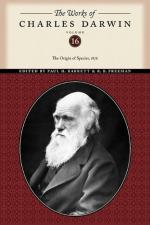The previous remarks on “single and multiple centres of creation” do not directly bear on another allied question,—namely whether all the individuals of the same species have descended from a single pair, or single hermaphrodite, or whether, as some authors suppose, from many individuals simultaneously created. With those organic beings which never intercross (if such exist), the species, on my theory, must have descended from a succession of improved varieties, which will never have blended with other individuals or varieties, but will have supplanted each other; so that, at each successive stage of modification and improvement, all the individuals of each variety will have descended from a single parent. But in the majority of cases, namely, with all organisms which habitually unite for each birth, or which often intercross, I believe that during the slow process of modification the individuals of the species will have been kept nearly uniform by intercrossing; so that many individuals will have gone on simultaneously changing, and the whole amount of modification will not have been due, at each stage, to descent from a single parent. To illustrate what I mean: our English racehorses differ slightly from the horses of every other breed; but they do not owe their difference and superiority to descent from any single pair, but to continued care in selecting and training many individuals during many generations.
Before discussing the three classes of facts, which I have selected as presenting the greatest amount of difficulty on the theory of “single centres of creation,” I must say a few words on the means of dispersal.
Means of dispersal.
Sir C. Lyell and other authors have ably treated this subject. I can give here only the briefest abstract of the more important facts. Change of climate must have had a powerful influence on migration: a region when its climate was different may have been a high road for migration, but now be impassable; I shall, however, presently have to discuss this branch of the subject in some detail. Changes of level in the land must also have been highly influential: a narrow isthmus now separates two marine faunas; submerge it, or let it formerly have been submerged,




